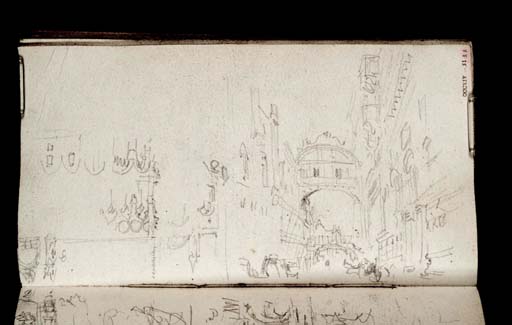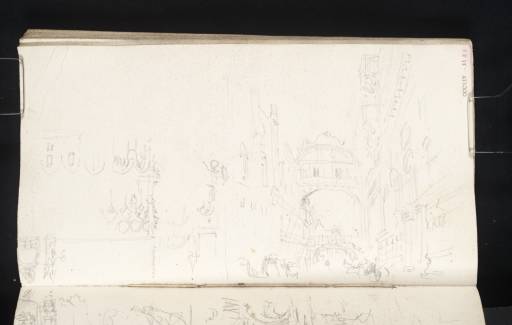Joseph Mallord William Turner The Bridge of Sighs, Venice, on the Rio del Palazzo between the New Prisons and Palazzo Ducale (Doge's Palace), with San Giorgio Maggiore Beyond; the South Front of the Palace and the Basilica of San Marco (St Mark's) 1833
Image 1 of 2
-
 Joseph Mallord William Turner, The Bridge of Sighs, Venice, on the Rio del Palazzo between the New Prisons and Palazzo Ducale (Doge's Palace), with San Giorgio Maggiore Beyond; the South Front of the Palace and the Basilica of San Marco (St Mark's) 1833
Joseph Mallord William Turner, The Bridge of Sighs, Venice, on the Rio del Palazzo between the New Prisons and Palazzo Ducale (Doge's Palace), with San Giorgio Maggiore Beyond; the South Front of the Palace and the Basilica of San Marco (St Mark's) 1833 -
 Joseph Mallord William Turner, The Bridge of Sighs, Venice, on the Rio del Palazzo between the New Prisons and Palazzo Ducale (Doge's Palace), with San Giorgio Maggiore Beyond; the South Front of the Palace and the Basilica of San Marco (St Mark's) 1833 (Enhanced image)Enhanced image
Joseph Mallord William Turner, The Bridge of Sighs, Venice, on the Rio del Palazzo between the New Prisons and Palazzo Ducale (Doge's Palace), with San Giorgio Maggiore Beyond; the South Front of the Palace and the Basilica of San Marco (St Mark's) 1833 (Enhanced image)Enhanced image
Joseph Mallord William Turner,
The Bridge of Sighs, Venice, on the Rio del Palazzo between the New Prisons and Palazzo Ducale (Doge's Palace), with San Giorgio Maggiore Beyond; the South Front of the Palace and the Basilica of San Marco (St Mark's)
1833
Joseph Mallord William Turner 1775–1851
Folio 31 Recto:
The Bridge of Sighs, Venice, on the Rio del Palazzo between the New Prisons and Palazzo Ducale (Doge’s Palace), with San Giorgio Maggiore Beyond; the South Front of the Palace and the Basilica of San Marco (St Mark’s) 1833
D31986
Turner Bequest CCCXIV 31
Turner Bequest CCCXIV 31
Pencil on white laid paper, 109 x 203 mm
Partial watermark: crescent moon with face in profile
Inscribed by C.F. Bell in black ink ‘31’ top right, ascending vertically
Stamped in black ‘CCCXIV – 31’ top right, ascending vertically
Partial watermark: crescent moon with face in profile
Inscribed by C.F. Bell in black ink ‘31’ top right, ascending vertically
Stamped in black ‘CCCXIV – 31’ top right, ascending vertically
Accepted by the nation as part of the Turner Bequest 1856
Exhibition history
2003
Turner and Venice, Tate Britain, London, October 2003–January 2004, Kimbell Art Museum, Fort Worth, February–May, Museo Correr, Venice, September 2004–January 2005, Fundació ”la Caixa”, Barcelona, March–June 2005 (79, as one of ‘Two views of the Bridge of Sighs, with a study of the Doge’s Palace’, 1840, reproduced in colour).
References
1909
A.J. Finberg, A Complete Inventory of the Drawings of the Turner Bequest, London 1909, vol.II, p.1013, CCCXIV 31, as ‘Bridge of Sighs and part of the Ducal Palace’.
1984
Hardy George, ‘Turner in Europe in 1833’, Turner Studies, vol.4, no.1, Summer 1984, p.14.
2003
Ian Warrell in Warrell, David Laven, Jan Morris and others, Turner and Venice, exhibition catalogue, Tate Britain, London 2003, p.271 no.79, as one of ‘Two views of the Bridge of Sighs, with a study of the Doge’s Palace’, 1840, fig.112 (colour).
Finberg later redundantly annotated his 1909 Inventory entry (‘Bridge of Sighs and part of the Ducal Palace’): ‘do. [i.e. ditto: B. Sighs] & part of Ducal Palace’.1 The Turner scholar C.F. Bell marked another copy: ‘Rio de Palazzo looking south’.2 He made a similar note in a copy of Finberg’s 1930 book In Venice with Turner.3 The page’s title was amended by Ian Warrell to ‘Looking down the Rio del Palazzo to the Bridge of Sighs, with San Giorgio Maggiore beyond; and the Southern Façade of the Doge’s Palace’ in 2003, in connection with his concurrent Turner and Venice exhibition at Tate Britain,4 where it and folio 30 verso opposite (D31985) were exhibited.5 The page was used horizontally for two separate studies, both ways up.
With the gutter at the bottom, the right-hand half shows the Bridge of Sighs high up between the New Prisons (on the left) and Palazzo Ducale (Doge’s Palace), looking down the Rio del Palazzo to the more conventional Ponte della Paglia and the dome of San Giorgio Maggiore across the Bacino to the south-south-east in the distance. Selected details of the complex, heavily articulated Renaissance stonework on the palace’s west side include two balconies and indications of the panels of diamond rustication above the waterline. The less elaborate stone-dressed brickwork at the back of the Ca’ dei Dogi on the left runs on to the start of the stone of the prisons just this side of the Bridge of Sighs.
There is another detailed view from south of the bridge on the opposite page, under which related views are noted. The two elevations are very similar, and although the oil of Venice, the Bridge of Sighs shown at the Royal Academy in 1840 (Tate N00527)6 depicts the structure from the other direction, the present drawing shows its stonework in the clearest detail and doubtless informed the painting.
Turner had first made a slight sketch of the present scene from a little further north in the 1819 Milan to Venice sketchbook (Tate D14388; Turner Bequest CLXXV 39a). As Warrell has observed, however,7 his vignette watercolour of about 1830 (private collection),8 engraved in 1832 as The Bridge of Sighs, Venice for Lord Byron’s Life and Works (Tate impression: T06650), was based on what must have been a detailed ‘sketch by T. Little, Esq.’, apparently an obscure amateur, as acknowledged in the print’s lettering.9 A night scene, again looking towards the Bacino (lit by a brilliant moon over San Giorgio), it shows the bridge from a dramatically close, oblique angle, framed by a fictitious corner of the palace with a wrought-iron balcony in the right foreground. The present drawing may have been made at least in part as a conscious corrective to that romantic but inaccurate composition.
The other way up on the left is a partial study of the Doge’s Palace from the Bacino, focusing on the western end of its south front. This serves to supplement the careful view of the waterfront and Piazzetta from a similar point on folio 30 recto (D31984), where the palace lay just out of sight beyond the right-hand edge. To the left here is the south-west corner of the basilica of San Marco (St Mark’s), seen beyond the Piazzetta to the north. Although at first glance the two seem parts of a continuous view, the church seems set as if somewhat higher and comprises a rather jumbled array of details, perhaps hastily noted while in motion – contrast the much more sustained study centred on this corner in the 1819 Milan to Venice sketchbook (Tate D14399; Turner Bequest CLXXV 45). On the present occasion, Turner’s eye was caught by a small Austrian cannon, like the one shown more prominently in an 1840 colour study of the Piazzetta by night (Tate D32220; Turner Bequest CCCXVIII 1).
The palace is also shown in typically selective detail (compare folios 5 verso and 8 verso; D31936, D31942), with slight indications of the integral sculpture at the ‘Fig-tree angle’ (as John Ruskin later called it),10 which Turner had also drawn in the earlier Milan to Venice book (Tate D14412; Turner Bequest CLXXV 51a). The open Gothic arches along the Molo and their narrower counterparts above are inaccurately proportioned and soon tail off, while the façade’s upper balcony, actually centred over the ninth of the ground-floor arches, is squeezed in at the right-hand edge, with its elaborate stone surround continued upwards on an exaggerated scale across the gutter onto D31985.
The drawings between folio 26 verso and here (D31977–D31986) may record a continuous short trip from the south-eastern end of the Grand Canal eastwards to the Bridge of Sighs. For this sketchbook’s convoluted general sequence, including Hardy George’s broad overview,11 see its Introduction.
Matthew Imms
May 2019
Undated MS note by Finberg (died 1939) in interleaved copy of Finberg 1909, Prints and Drawings Room, Tate Britain, II, opposite p.1013.
Undated MS note by Bell (died 1966) in copy of Finberg 1909, Prints and Drawings Room, Tate Britain, II, p.1013.
Undated MS note by Bell in copy of A.J. Finberg, In Venice with Turner, London 1930, Study Room, British Museum, London, p.169, as transcribed by Ian Warrell (Tate cataloguing files, as ‘before 1936’).
Martin Butlin and Evelyn Joll, The Paintings of J.M.W. Turner, revised ed., New Haven and London 1984, p.235 no.383, pl.386 (colour).
How to cite
Matthew Imms, ‘The Bridge of Sighs, Venice, on the Rio del Palazzo between the New Prisons and Palazzo Ducale (Doge’s Palace), with San Giorgio Maggiore Beyond; the South Front of the Palace and the Basilica of San Marco (St Mark’s) 1833 by Joseph Mallord William Turner’, catalogue entry, May 2019, in David Blayney Brown (ed.), J.M.W. Turner: Sketchbooks, Drawings and Watercolours, Tate Research Publication, March 2023, https://www

